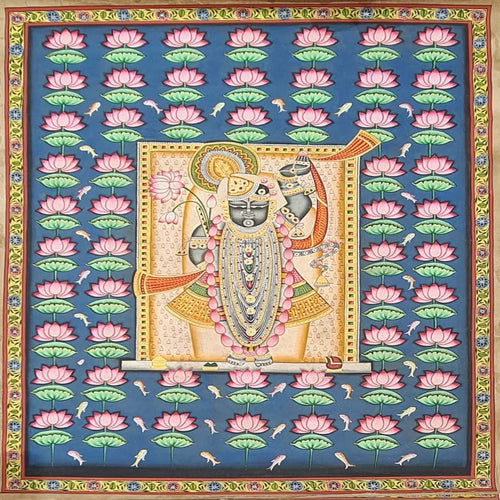About Pichwai
Pichwai art (also known as pichhavai, pichhvai, pechhavai etc), a traditional Indian art form, originated around 400 years ago in the temple town of Nathdwara, Rajasthan. The word "Pichwai" comes from "pich" (meaning "back") and "wai" (meaning "textile wall hanging"). These intricate artworks were originally created as backdrops for the deity Shrinathji, a form of Lord Krishna, at the Nathdwara temple. Over time, Pichwai paintings have transcended their temple origins, now adorning homes, offices, and decorative items like cushion covers and carpets. They stand as a testament to the rich cultural heritage of India, blending devotion with artistic beauty.
History and Tradition
The history of Pichwai paintings is closely linked to the 17th-century Nathdwara temple. In 1672, Shrinathji, a form of Krishna as a 7-year-old child, was being transported from Mathura. During the journey, the bullock cart carrying the idol got stuck in the mud near Nathdwara, which devotees interpreted as divine intervention. This led to the establishment of the Shrinathji temple in Nathdwara, where Pichwai paintings began as intricate backdrops to honor the deity. These paintings were meant to reflect the changing seasons, festivals, and moods of Lord Krishna, eventually evolving into a distinct art form.
The central figure in most Pichwai paintings is Shrinathji, depicted in various forms and scenes from Krishna’s life. These artworks are a visual expression of devotion, illustrating different legends, including Krishna’s childhood antics, the Raas Leela, and his interactions with gopis and cows. The paintings are often made to celebrate specific festivals, including Nand Mahotsav, Daan Leela, and Sandhya Aarti, reflecting Krishna’s divine role in Hindu culture.
Themes
Pichwai paintings predominantly revolve around the themes of devotion, love, and nature, often showcasing Shrinathji in various forms. Some popular themes include:
- Krishna’s Life: Episodes like Daan Leela, Raas Leela, and Gopashtami, where Krishna interacts with gopis and cows, are depicted.
- Festivals: Pichwai paintings highlight important Hindu festivals such as Janmashtami, Nand Mahotsav, and Sandhya Aarti.
- Seasons: There are seasonal Pichwais, such as Summer Pichwai (decorated with lotuses) and Morkuti Pichwais (peacocks dancing to welcome monsoon).
- Flora and Fauna: Common motifs include lotuses, peacocks, cows, and trees, symbolizing nature and Krishna’s divine connection to the pastoral world.
Materials and Methods
Traditionally Pichwai paintings were created using natural materials. The canvas was made of handspun, starched cotton cloth, while the brushes were crafted from goat, squirrel, and horse hair. The colors were derived from natural sources like coal, zinc, indigo, saffron, gold, and silver. This painstaking process could take days to complete. Over time, modern techniques have been adopted, but the intricate detailing and vibrant hues remain core to the Pichwai aesthetic.
The process typically begins with a rough sketch, followed by the application of colors. Depending on the style, some paintings are further embellished with gold threads, crystals, or stones to create a more ornate finish. The bright color palette—featuring reds, yellows, greens, and blacks—adds to the visual vibrancy, with each color symbolizing different elements of Krishna’s life.
Significance
Pichwai paintings are significant not just as devotional objects but also as representations of India’s rich artistic and spiritual heritage. They serve as a visual expression of the devotion toward Krishna and celebrate his connection to nature, gopis, and cows. The intricate motifs, from lotuses symbolizing purity to cows representing fertility, are imbued with cultural symbolism.
These paintings also hold contemporary relevance, finding a place in modern homes and galleries. While the large, elaborate temple Pichwais have been scaled down to fit contemporary spaces, they continue to evoke the beauty and spirituality inherent in the original form.
FAQs
Can Pichwai paintings be customized?
Yes, MeMeraki offers customization options for Pichwai paintings. You can discuss specific themes, colors, or sizes with us. Custom orders may require additional time for completion, so be sure to inquire about the expected delivery time.
Are Pichwai paintings suitable for gifting?
Pichwai paintings make unique and meaningful gifts, especially for those interested in devotional art or Hindu culture. Their intricate designs and spiritual significance make them a special choice for occasions such as weddings, anniversaries, and religious ceremonies.
What are the benefits of buying a Pichwai painting from MeMeraki?
At MeMeraki, you benefit from our curated selection of authentic Pichwai paintings, detailed product descriptions, and professional customer service. We offer blogs and workshops to deepen your understanding of Pichwai art and its cultural significance.
How can I learn more about Pichwai painting?
Explore MeMeraki’s blogs and workshops for in-depth insights and learning opportunities about Pichwai painting. Additionally, you can reach out to our customer service for further information.
Highlights of Pichwai Artform
| Artform | Pichwai |
|---|---|
| Origin | |
| Materials Used | |
| Colours Used | |
| Popular Themes | |
| Price Range | |
| Artists | |
| Making Process | Handmade |














